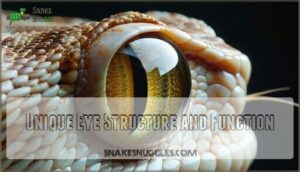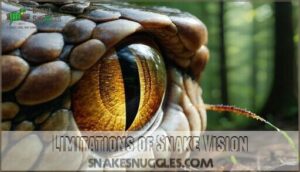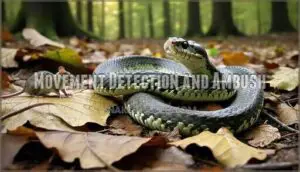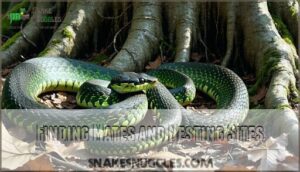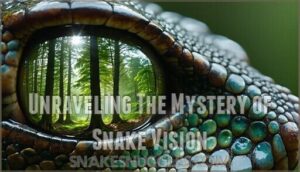This site is supported by our readers. We may earn a commission, at no cost to you, if you purchase through links.
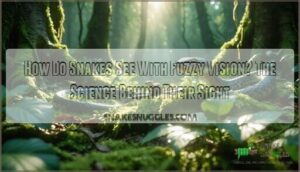
Snakes have relatively poor visual acuity, meaning they can’t focus sharply on objects. Their world appears blurry compared to what you’d see.
However, they’ve evolved incredible compensations for this limitation. They excel at detecting movement, which is vital for spotting prey and predators.
Many species also possess specialized heat-sensing pit organs that create thermal images, giving them "heat vision" to locate warm-blooded prey in complete darkness.
This combination of fuzzy regular vision plus heat detection creates a unique sensory experience that’s perfectly adapted to their hunting lifestyle and survival needs.
Table Of Contents
- Key Takeaways
- Snake Eye Cloudiness Explained
- How Snakes See The World
- Snake Vision in Action
- Common Eye Problems in Snakes
- Unraveling The Mystery of Snake Vision
- Frequently Asked Questions (FAQs)
- Do snakes have blurry vision?
- Do snakes have bad eyesight or not?
- Do snakes see with their eyes or tongue?
- What does a snake’s vision look like?
- Why do my snakes’ eyes look cloudy?
- Do all snakes have bad eyesight?
- Can snakes see in the dark?
- Do snakes have good eyesight?
- Can snakes see underwater?
- Do snakes have night vision?
- Conclusion
Key Takeaways
- You’ll notice your snake’s vision is about ten times blurrier than yours, but they’ve evolved specialized abilities like exceptional movement detection and heat-sensing pit organs that make them highly effective hunters despite this limitation.
- When your snake’s eyes look cloudy, it’s usually normal shedding (spectacle scales loosening), but can also indicate dehydration, cataracts, or infections that need veterinary attention.
- You’ll find snakes use dichromatic vision focused on blue-green wavelengths with excellent contrast detection and UV sensitivity, allowing them to spot prey movement even in low-light conditions.
- Your snake navigates the world through sensory integration—combining their fuzzy eyesight with heat detection, chemical cues from tongue-flicking, and vibration sensing to create a complete environmental picture.
Snake Eye Cloudiness Explained
If you’ve noticed your snake’s eyes looking cloudy or hazy, you’re witnessing one of several natural or health-related processes that affect their vision.
This cloudiness can range from temporary conditions like shedding cycles to more serious issues requiring veterinary attention, such as health problems that may cause cloudiness.
Shedding and Cloudy Eyes
Notice your snake’s eyes turning cloudy before shedding? Don’t panic—this natural process occurs when the spectacle (transparent eye covering) loosens, creating that distinctive bluish haze that temporarily affects your snake’s fuzzy vision.
Key shedding indicators include:
- Milky appearance develops 7-10 days before actual shed
- Spectacle retention can occur if humidity levels drop too low
- Post-shed vision returns to normal clarity within hours
- Abnormal shedding patterns may indicate underlying health issues
The spectacle protects snake eyesight like a permanent contact lens, and lubrication importance can’t be overstated—proper humidity guarantees smooth shedding cycles and prevents complications that could impact long-term snake vision quality.
Cataracts and Permanent Damage
When cataracts cloud your snake’s lens, permanent blindness becomes a real threat.
Cloudy lenses steal sight—act fast before darkness wins.
Unlike temporary shedding cloudiness, cataracts cause lasting eye trauma and blurred vision.
However, cataract surgery offers hope for vision restoration.
Cataracts in reptiles can also be caused by inappropriate UV exposure.
| Cataract Stage | Snake Vision Impact | Treatment Options |
|---|---|---|
| Early cataracts | Mild fuzzy vision | Monitor, improve nutrition |
| Mature cataracts | Severe snake eyesight loss | Cataract surgery recommended |
| Advanced cataracts | Complete permanent blindness | Surgery or adaptation strategies |
Damage prevention through proper nutrition and veterinary care protects your snake’s vision long-term.
Dehydration and Eye Film
When your snake’s eyes look cloudy, dehydration might be the sneaky culprit.
Dehydration symptoms include spectacle cloudiness that creates a film over their eyes, causing vision impairment and blurred vision.
This fuzzy vision temporarily affects snake vision, but here’s the good news: proper hydration solutions and preventative measures like maintaining adequate water sources usually clear up the cloudiness completely.
Maintaining proper humidity, as well as preventing retained spectacles, is essential for their well-being.
Sickness and Infections
Beyond dehydration, various illnesses can cloud your snake’s vision and signal serious health concerns.
Eye Infections, Parasitic Diseases, Vitamin Deficiency, and Scale Rot often manifest through cloudy or hazy eyes, affecting snake vision substantially.
- Respiratory infections – Create mucus buildup around eyes
- Mouth rot – Spreads bacteria affecting nearby eye tissue
- Inclusion body disease – Causes neurological symptoms and poor vision
- Parasitic infections – Internal parasites weaken immunity, leading to eye problems
These conditions require immediate veterinary attention to prevent permanent blindness or cataracts.
Blindness and Impaired Vision
When genetic blindness or injury-related blindness strikes, you’ll notice profound vision loss impact on your snake’s behavior.
However, sensory compensation kicks in remarkably well. Blind snake care requires minimal adjustments since these reptiles rely heavily on heat detection and chemical cues rather than sharp eyesight for survival.
| Blindness Type | Key Characteristics |
|---|---|
| Congenital | Present from birth, often genetic |
| Age-related | Gradual onset in older snakes |
| Injury-induced | Trauma or infection damage |
| Cataracts | Cloudy lens obstruction |
| Complete | Total vision absence |
How Snakes See The World
You might think snakes can’t see much with their fuzzy vision, but they’ve mastered a completely different way of viewing the world that’s perfectly suited to their survival needs.
Snakes don’t need perfect eyesight—they’ve turned blur into their ultimate hunting advantage.
While their eyesight lacks the sharp detail you’re used to, snakes have evolved specialized visual abilities that make them incredibly effective hunters and survivors in their environments.
Unique Eye Structure and Function
Unlike humans, your snake’s eye structure features spectacle scales instead of eyelids—transparent protective covers that shed with their skin.
Each eye contains a spherical lens that provides sharper focus than human eyes, though with fixed focus limitations.
The retina cells detect light and movement effectively, while vertically elliptical pupil shape controls light entry, creating the characteristic fuzzy vision that defines snake eyes.
Some species also have infrared radiation detection, enhancing their environmental awareness.
Here’s how snake vision works through this unique eye structure:
- Spectacle scales protect eyes without blinking capability
- Spherical lens focuses light onto specialized retina cells
- Fixed focus system prioritizes movement detection over sharp details
This streamlined design explains their visual limitations while maximizing survival advantages.
Limitations of Snake Vision
How sharp is your eyesight compared to a snake’s? Snake vision operates with significant visual limitations that make their world appear fundamentally different from ours.
Their visual acuity is roughly ten times lower than humans, creating fuzzy vision with low resolution detail.
Fixed focus lenses can’t adjust like ours, while static vision struggles with depth perception.
Poor color perception further restricts clarity, though excellent movement detection compensates for these visual shortcomings.
Color Vision and Contrast
You might think snakes see life like an old black-and-white TV, but their dichromatic vision tells a different story.
Their color perception focuses on two primary colors—typically blue-green wavelengths—while maintaining remarkable contrast detection abilities. Sea snakes, however, have evolved to regain color vision.
Here’s how snake visual acuity works in their favor:
- UV sensitivity helps nocturnal species navigate darkness effectively
- Enhanced contrast detection spots moving prey against static backgrounds
- Specialized retinal cells optimize performance in varying light conditions
- Dichromatic vision reduces visual complexity while maintaining essential information
- Color vision adaptations match each species’ hunting and survival needs
This streamlined reptile vision system proves that sometimes less complexity means better survival.
Movement Detection and Ambush
Movement detection forms the backbone of snake vision and ambush predators‘ success.
While you can’t rely on sharp detail, snakes excel at spotting even tiny movements.
Their hunting strategy involves camouflage reliance and patience—waiting motionless until prey moves within range.
Pit organ use enhances this prey detection, while specialized neurons process motion signals instantly.
This evolutionary advantage creates deadly strike accuracy, making ambush strategies incredibly effective despite fuzzy eyesight.
Snake Vision in Action
You’re about to see how snakes turn their fuzzy eyesight into a survival advantage that’s surprisingly effective.
Despite having vision that’s roughly ten times blurrier than yours, these reptiles have mastered the art of detecting movement, traversing complex environments, and hunting with remarkable precision.
Locating Prey and Avoiding Predators
Hunting Strategies vary dramatically among snake species, but all rely heavily on snake vision for prey detection and predator detection.
You’ll find that motion detection acts as their primary hunting tool – a flickering tail or shifting shadow instantly triggers their strike response.
Their Sensory Integration combines visual cues with heat-sensing abilities, creating a thorough targeting system.
Hunting Strategies that depend on Camouflage Reliance showcase how snakes maximize their fuzzy vision.
- Defensive Displays like hood-flaring or tail-rattling warn predators while snakes assess escape routes
- Heat-sensing pit organs supplement vision for precise strikes in complete darkness
- Environmental Navigation helps snakes position themselves along prey trails and hunting corridors
Navigating The Environment
Through their fuzzy vision, snakes navigate complex terrain using movement detection and sensory integration.
You’ll find them lifting their heads to scan for obstacles, relying on contrast changes to identify safe paths.
Their environmental adaptation combines poor depth perception with excellent predator avoidance instincts.
Nocturnal hunting species depend heavily on habitat navigation through thermal cues and ground vibrations.
Finding Mates and Nesting Sites
Beyond navigation, snakes face another challenge where their fuzzy vision becomes surprisingly useful.
You’ll find that mate selection relies heavily on movement patterns and visual cues during breeding season.
When searching for partners, snakes can detect the distinctive undulating motions of potential mates, even with their limited visual acuity.
Nesting behavior showcases how snake vision works alongside other senses.
Their eyes help identify dark, sheltered spots perfect for egg-laying, while movement detection keeps them alert to threats during vulnerable periods.
Here’s how snakes use their sight for reproduction:
- Visual cues help distinguish between male and female movement patterns during courtship
- Habitat preferences guide them toward suitable nesting sites with proper cover
- Movement detection alerts them to predators while they’re focused on mating rituals
- Pheromone signals work with visual input to confirm mate compatibility
- Environmental scanning helps locate secure areas for egg deposition
This combination of fuzzy vision and chemical detection creates an effective system for species continuation.
Survival and Adaptation
You can’t survive without adapting, and snakes prove this through their visual acuity and snake hunting strategies.
Their sensory reliance compensates for fuzzy vision, using snake prey detection through movement patterns.
Environmental pressures shaped these evolutionary advantages, creating behavioral impacts that boost hunting success.
Snake vision may lack sharpness, but snake visual adaptations excel at spotting threats and opportunities, making survival possible in harsh conditions.
Common Eye Problems in Snakes
You’ll notice that snakes can develop several eye problems that affect their already limited vision, from temporary cloudiness during shedding to more serious conditions like cataracts.
Understanding these common issues helps explain how these remarkable creatures adapt when their sight becomes even more compromised than usual, which is a key aspect of their ability to survive with limited vision.
Cloudy Eyes and Underlying Causes
Identifying the root cause of cloudy snake eyes requires careful observation since multiple factors can trigger this condition.
When your snake’s spectacle scales appear hazy, you’re witnessing one of several possible scenarios that range from natural processes to serious health concerns.
Three primary causes create this cloudy appearance:
- Shedding Complications: The spectacle scales loosen before molting, creating temporary opacity that resolves naturally
- Cataract Surgery: Age-related lens clouding may require veterinary intervention for vision preservation
- Infection Signs: Respiratory illness or bacterial infections often manifest through cloudy eyes alongside other symptoms
Vision Impairment from these causes varies substantially.
While shedding-related cloudiness disappears completely, cataracts can cause permanent blindness without treatment.
Dehydration Effects also contribute to temporary haziness, making proper humidity essential for maintaining clear snake vision and healthy snake eyes.
Dehydration and Eye Health
After cloudy eyes, dehydration is another sneaky culprit affecting snake vision.
When your snake’s water bowl runs dry or humidity drops, you might spot a hazy film over those spectacle scales.
This temporary cloudiness can mess with their visual acuity and even cause shedding difficulty.
Proper snake enclosure management is very important.
Hydration’s impact is huge—fresh water and proper humidity are simple preventative measures to keep snake eyes clear and avoid vision impairment or blindness.
Cataracts and Surgical Treatment
Cataract formation occurs when protein buildup clouds your snake’s lens, creating vision problems similar to looking through frosted glass. These Cataract Causes include aging, trauma, genetic factors, and excessive UV exposure, making Prevention Methods like proper lighting essential for maintaining healthy snake vision.
When cataracts develop, Surgical Options exist through phacoemulsification:
- Diagnosis – Veterinary specialists use biomicroscopy and ultrasonography to assess lens opacity
- Surgery – The cloudy lens is removed under anesthesia, sometimes with artificial lens implantation
- Post-Op Care – Medication administration and monitoring prevent complications like corneal edema
- Visual Recovery – Successful procedures restore normal feeding and environmental exploration behaviors
Professional veterinary care remains essential since not all cases require surgery, especially when snake eyes maintain adequate function for captive life. Protective eyewear can also help in snake bite prevention.
Blindness and Environmental Adaptation
When blindness strikes your snake through age, injury, or genetics, you’ll notice their eyes turn bluish-gray and opaque.
While snake vision wasn’t perfect to begin with, complete blindness creates real challenges for environmental adaptation. Your blind snake relies heavily on sensory compensation—using their tongue, heat detection, and vibrations to navigate snake habitats.
Blind snake behavior shows remarkable adaptation as they depend more on familiar territories. However, habitat dependence increases substantially since they can’t spot distant movements or threats.
Evolutionary pressures shaped snakes to survive visual limitations, but complete blindness tests these boundaries. You’ll need to create safer enclosures, as conservation implications include reduced hunting success and increased vulnerability to predators in wild populations.
Prioritize their safety with a secure habitat setup.
Unraveling The Mystery of Snake Vision
You’re about to discover how scientists decipher the secrets of snake vision through cutting-edge research methods.
From sophisticated lab experiments that measure electrical signals in snake brains to field studies observing hunting behaviors, researchers continue making breakthrough discoveries about these remarkable predators’ visual world.
Electrophysiology and Behavioral Experiments
A closer look at snake vision research reveals some fascinating science.
Using electrophysiology and behavioral assays, scientists study how neural processing and sensory integration shape what snakes see.
You’ll find that:
- Behavioral experiments show snakes respond more to movement than color, thanks to motion-focused stimulus response.
- Vision modeling confirms snakes have limited visual acuity, relying on contrast over fine details.
- Electrophysiology maps out how their brains process both visual and heat cues.
So, while snakes see the world fuzzier than us, their brains make the most of every shadow and flicker.
Ongoing Research and New Discoveries
Scientists aren’t stopping their quest to understand snake vision research. Recent snake vision studies reveal fascinating Dichromatic Insights about how snakes process only two primary colors.
UV Perception research shows some species detect ultraviolet light for navigation. Infrared Advancements continue exploring heat-sensing capabilities that outperform artificial sensors by tenfold.
Evolutionary Biology investigations trace vision adaptations from ancient burrowing ancestors. Material Science applications emerge from studying snake eye structures.
Discoveries are fueling specialized product development. These snake vision findings reshape our understanding of snake vision genetic development and snake vision evolutionary perspective, promising breakthrough discoveries ahead.
Snake Vision and The Scientific Community
You’ll find researchers worldwide studying snake vision through cutting-edge methods.
Vision research reveals how dichromatic perception and UV sensitivity shape their world.
Scientists explore infrared advancements inspired by pit organs, which outperform artificial sensors tenfold.
Evolutionary biology explains why fuzzy visual perception suits most species perfectly.
Adaptations include UV sensitivity for certain snake species.
These snake vision studies continue uncovering findings that revolutionize our understanding of visual systems.
Frequently Asked Questions (FAQs)
Do snakes have blurry vision?
While you might think snakes are nearly blind, they’re not.
They have blurry vision compared to humans – about ten times less sharp – but they’re experts at detecting movement and contrasts, which helps them hunt and survive effectively, using their ability to detect movement.
Do snakes have bad eyesight or not?
Snakes don’t have universally bad eyesight.
Their vision varies by species – diurnal snakes see quite well, while nocturnal ones rely more on heat detection and scent, making their eyesight less sharp.
Do snakes see with their eyes or tongue?
Ironically, you’d think snakes rely solely on sight, but they’re actually master multitaskers.
They use both eyes for basic vision and their forked tongues to "taste" chemical trails, creating a complete sensory picture of their world.
What does a snake’s vision look like?
Through your eyes, a snake’s world appears blurry and muted—like looking through frosted glass. You’d see mostly grays, blues, and greens with excellent movement detection but poor detail resolution.
Why do my snakes’ eyes look cloudy?
Don’t get your scales in a twist! Cloudy eyes typically indicate your snake’s preparing to shed, though dehydration, cataracts, or illness can also cause this condition.
Do all snakes have bad eyesight?
You’ll find that eyesight quality varies dramatically among snake species.
Diurnal snakes like colubrids have sharp vision for hunting, while nocturnal species rely more on heat-sensing and scent than visual details.
Can snakes see in the dark?
Most snakes can see fairly well in darkness thanks to their eyes containing many rod cells, which excel at detecting light and movement in low-light conditions.
Do snakes have good eyesight?
Most snakes don’t have sharp eyesight like you’d expect.
Their vision’s actually quite fuzzy compared to humans, with visual acuity about ten times lower than ours.
However, they’re excellent at detecting movement and changes in contrast, which helps them spot prey and avoid predators effectively.
Can snakes see underwater?
Like looking through a foggy window, you’ll find snakes can see underwater, but their already fuzzy vision becomes even more blurred due to water’s refractive properties and their fixed-focus lenses.
Do snakes have night vision?
Yes, snakes have excellent night vision due to their high concentration of rod cells, which are specialized for detecting light in dark conditions.
You’ll find nocturnal species particularly well-adapted for low-light hunting, with excellent night vision capabilities.
Conclusion
Understanding how do snakes see with fuzzy vision reveals nature’s remarkable adaptability, doesn’t it?
While snakes can’t achieve sharp focus like humans, they’ve developed extraordinary compensatory abilities that make them successful predators.
Their heat-sensing capabilities, movement detection skills, and specialized visual processing create a unique sensory world perfectly suited to their ecological niche.
This fuzzy vision isn’t a limitation—it’s an evolutionary adaptation that demonstrates how organisms thrive using different sensory strategies than our own.
- https://www.nhm.ac.uk/discover/news/2016/september/study-sheds-light-on-snake-vision.html
- https://www.reddit.com/r/interestingasfuck/comments/12g37i4/snake_vision_compared_to_human_vision/
- https://www.nytimes.com/2015/09/27/magazine/far-away-from-here.html
- https://www.dailymail.co.uk/sciencetech/article-8365231/amp/Sea-snakes-adapting-underwater-15-million-years.html
- https://www.nature.com/articles/news.2010.122

